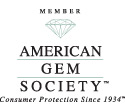Gem Treatments
Not all gemstones are created equal. Some can come straight out of the ground, ready to be polished and set into fine jewelry. However, most colored stones require some form of treatment to make them ready for use. A gem treatment (or enhancement) is defined as any traditional process, other than cutting and polishing, that improves the appearance (color/clarity/phenomena), durability, or availability of a gemstone.
Mardon Jewelers is committed to carrying high quality gemstones. In order to help our clients learn more about the treatments done to their gems, we’ve prepared descriptions of the most common types. For a much more in-depth summary, you can download AGTA's free Gemstone Information Manual. You can also learn more about the practical implications of gem ehancement in the Mardon colored stone grading system.
Heat Treatment: Gems may be heated to enhance clarity, color, or both. Many gems, including Ruby, Sapphire, and Tanzanite, are routinely heat treated to improve color and/or clarity. In fact, we always assume these stones have been heated unless they are certified otherwise or we can prove no heat treatment by careful gemological examination of the gems.
Heat Treatment with Diffusion: Gems may be heated in the presence of substances that significantly alter their color. Within the last decade, rubies and sapphires have been heated with beryllium present, which penetrates into the structure of the gem crystal and causes significant alteration of the natural color of the stone. For example, yellow and pink sapphires are turned “Padparadscha” orange by this process. Generally, these diffused color gems have substantially less value than gems with normal heat treatment (no diffusion) or no heat treatment.
Oil Treatment: Gems may be oiled to enhance their appearance. Due to their formation process and geological history, virtually all emerald crystals develop characteristic feathers, fissures, and inclusions, sometimes referred to as "jardin." Colorless oils or resins are used to fill these inclusions, improving the apparent clarity of the stone. It is estimated that 99% of all emeralds receive some form of this treatment.
ExCel Treatment: A relatively new Emerald treatment, ExCel uses a colorless polymer in place of oil or resin. The primary benefit is its durability - emeralds treated with Excel should be safe even in ultrasonic or steam cleaners.
Dyed: Some gem materials are porous, and can be dyed to improve their color. This treatment is often used to create unique and interesting colors in pearls that are difficult or impossible to find in nature.
Not treated or enhanced. Some gems, such as peridot, spinel, and garnet, do not require treatment. Exceptional specimens of other gems can always be found, but these usually command much higher prices.







